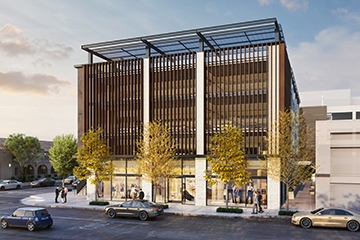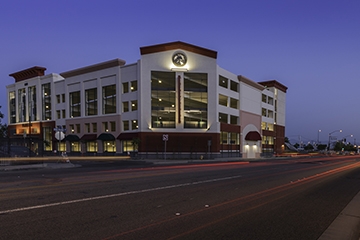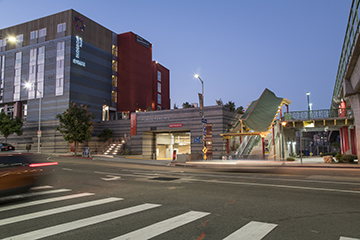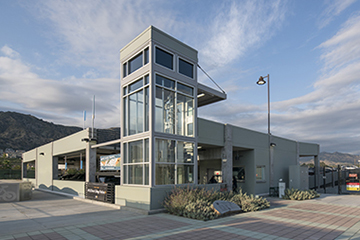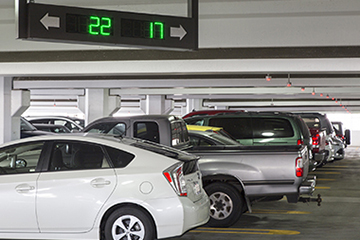Parking Professional: Making an Entrance....And an Exit: How Downtowns can Leverage Parking to Enhance the Arrival Experience
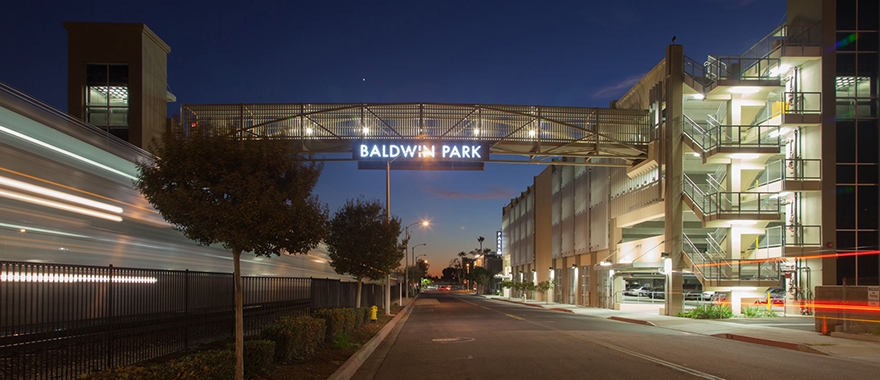
When we think of a parking structure as simply a storage place for cars, it’s easy to see it as an end point: its purpose and function are fulfilled once a car is parked. However, the experience someone has as they drive in, park and step out of their vehicle is an equally important part of the journey. If the parking experience is negative, it affects everything that follows. From public art to public spaces, there are a number of best practices that downtowns can utilize to elevate parking beyond the functional, integrate it into the larger whole and make it a transformative experience.
Setting the tone
How many times have you thought about going downtown to see the sights, do some shopping, or take advantage of the nightlife only to cringe at the thought of having to park? Before even setting foot out the door you have already created a negative impression about the experience you’re about to have. Now imagine how different you might feel if parking was a seamless, stress-free endeavor? For example, when the city of Brea, California opened its newest public parking structure, it was integrated into an existing parking guidance system that notifies drivers on Brea Boulevard of the amount of parking available in all three structures. To make parking an even smoother experience for drivers, the city also offers a mobile app that displays real time parking availability and turn-by-turn directions to aid users visiting the downtown, making it easier to find available parking.
In an effort to relieve parking pains in the popular tourist destination of Laguna Beach, California, the city integrated parking into its official app. In addition to tips on local highlights, restaurants and shops, the app points visitors towards public lots, provides parking tips and also offers live updates on a complimentary trolley service aimed to reduce congestion.
To improve customer service for visitors to its historic Old Towne District, the City of Orange, California implemented a valet program aimed at easing the challenge of finding an open parking space at the popular retail and dining destination. The service offers a ticketless system that allows users to manage their vehicle through a smartphone.
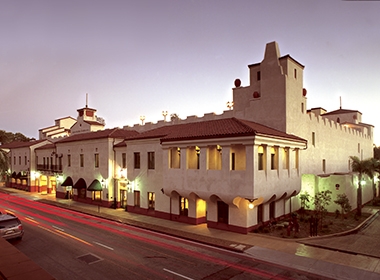 Granada Garage
Granada Garage
Warm Welcome
All too frequently, visitors to a downtown parking structure are met with a nondescript, utilitarian structure that’s dark, confusing and even intimidating. This can have a profound affect not only on the mood of the user, but can also dampen their enthusiasm to even make their journey in the first place. However if we approach parking as an architectural extension of the community, we open up tremendous opportunities to celebrate urban identity.
This is the approach that the city of Santa Barbara, California took with the Granada Garage, which presents a treasure trove of Mission Revival architectural details that makes parking a destination in and of itself. From the wrought iron balconies to terra cotta vases and detailed custom signage, the Granada Garage provides a spectacular welcome to downtown visitors while complementing the historic architectural context of downtown.
A new parking structure in Santa Clarita, California took a similar approach. The Old Town Newhall garage incorporates faux retail store fronts and historical downtown detailing that blends the parking structure into the surrounding architecture of the historic entertainment district, making the parking structure a charming component of the local scenery.
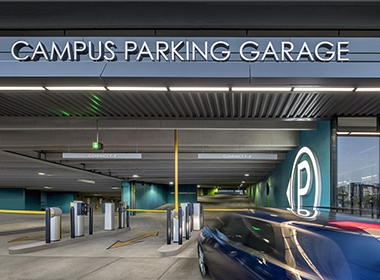 Phoenix Biomedical Campus Parking Structure
Phoenix Biomedical Campus Parking Structure
That welcoming feeling doesn’t have to be restricted to exterior architecture. Instead of drab, nondescript walls, users entering the Phoenix Biomedical Campus parking structure in downtown Phoenix, Arizona are greeted with bold colors and imaginative signage that sets the tone for the rest of their visit. In downtown Palo Alto, California, users exit their vehicles into an open, airy garage with natural light brought in by light well, magnified by a bright white interior. Color-coded signage featuring artwork of different birds for each level of the structure provides easy wayfinding and helps visitors remember where they parked.
Lasting Impression
Public art presents an opportunity for communities to transform parking structures from the utilitarian to an expression of place. If we think of parking as the first impression visitors have of their destination, public art can provide a way to celebrate identity and forge a more human, intimate connection with a space. For instance, when the Metro Gold Line Foothill Extension was constructed through Arcadia, Monrovia, Irwindale and Azusa, each city used public art to express its unique history at their respective station and parking structure, creating an experience for visitors at the moment of both their arrival and their departure. Seeing the potential, the City of Boulder is currently exploring an initiative to install public art on existing garages in an effort to create “gateways” to the city.
The same can be true for mixed use developments. Olympia Place, a mixed-use development in Walnut Creek, California, used a beautiful copper sphere sculpture as a parking structure’s focal point. The city of Morgan Hill, California saw their new Fourth Street Parking Garage as an opportunity to create a dramatic statement. The garage features a sculpture of an ornate, twelve foot wide tarantula that is native to the area and the subject of an annual festival. In addition to serving as a definitive conversation piece, the artwork also celebrates the city’s identity. In fact, the parking structure and its tarantula have been viewed as instrumental in revitalizing the downtown area.
By integrating public art into their parking, these downtowns create an arrival and departure experience that leaves a lasting impression.
Spaces to Linger
Just imagine if upon parking your car, instead of exiting into a concrete alley or onto a busy intersection, you traveled through a landscaped plaza with park benches and live music on the way to your destination. Public spaces, such as plazas or parklets, create a means for people to interact with each other and their environment in meaningful ways as they transition from their vehicles to pedestrian areas. Suddenly, parking is part of that experience instead of an isolated component – and in a positive way.
This is proving to be an effective approach for transit stations. The city of Arcadia, California chose to nestle a public plaza between a parking structure and the Metro Gold Line Arcadia Station, envisioning it as a way to create a sense of community between the parking structure and multiple transportation modes, from the station and bus stops to bicycle and pedestrian facilities. A parking structure for the forthcoming Milpitas BART extension will include a landscaped urban plaza capable of hosting food trucks. These spaces create a reason for people to linger, enjoy the scenery or socialize, leading to greater value for an area as a whole.
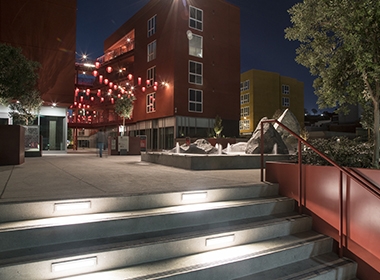 Blossom Plaza
Blossom Plaza
Public spaces can also be integrated into the parking structure itself. The roof of a subterranean garage at Blossom Plaza, a transit-oriented development in downtown Los Angeles, serves as a public plaza accented with landscaping and a water feature, creating a pleasant and enjoyable transition between the residential towers and Metro station. The Old Town Newhall structure in Santa Clarita will feature event space on the top deck, truly making the parking structure an active part of the community.
Meaningful Connections
By designing an enriched pedestrian experience into the journey, we ultimately create a better destination. This means going beyond providing a means to get from point A to point B simply and safely. How does that transition add to the experience? In what ways can we take the opportunity to set the tone for the next stage of the journey?
The city of Baldwin Park, California took these questions to heart with a parking structure designed to support their vision of a pedestrian-friendly urban transit center. The facility features an iconic pedestrian bridge that safely escorts transit riders from the parking structure across the railroad tracks to the train station. A public parklet provides links to both regional and local buses, the rail station and City Hall, and a pedestrian path provides connectivity to a future mixed-use development on the other side of City Hall that is now under construction.
To achieve the high level experience that the city of Palo Alto, California wishes to provide for its downtown visitors, plans for a new parking structure call for a pedestrian arcade adorned with public art. This innovative approach not only creates a safer experience by widening an existing narrow sidewalk, but it also makes the pedestrian journey a memorable one by creating a meaningful connection to the character of downtown.
Integrating parking into the arrival experience can be an effective way to make parking part of the journey. Since parking is the first and last experience a person has, we can create better destinations when we focus on the human element. From making lasting impressions with architecture and public art to enhancing the transition from vehicle to pedestrian with enjoyable public spaces and pathways to enriching the user experience, remember, “It’s not the journey, it’s the parking!”



